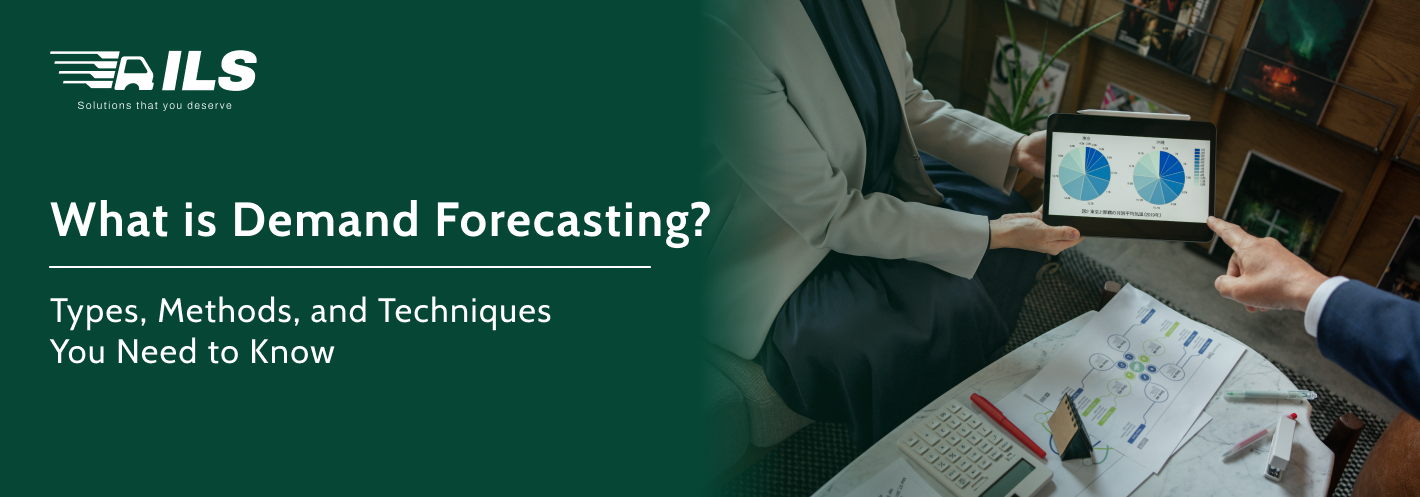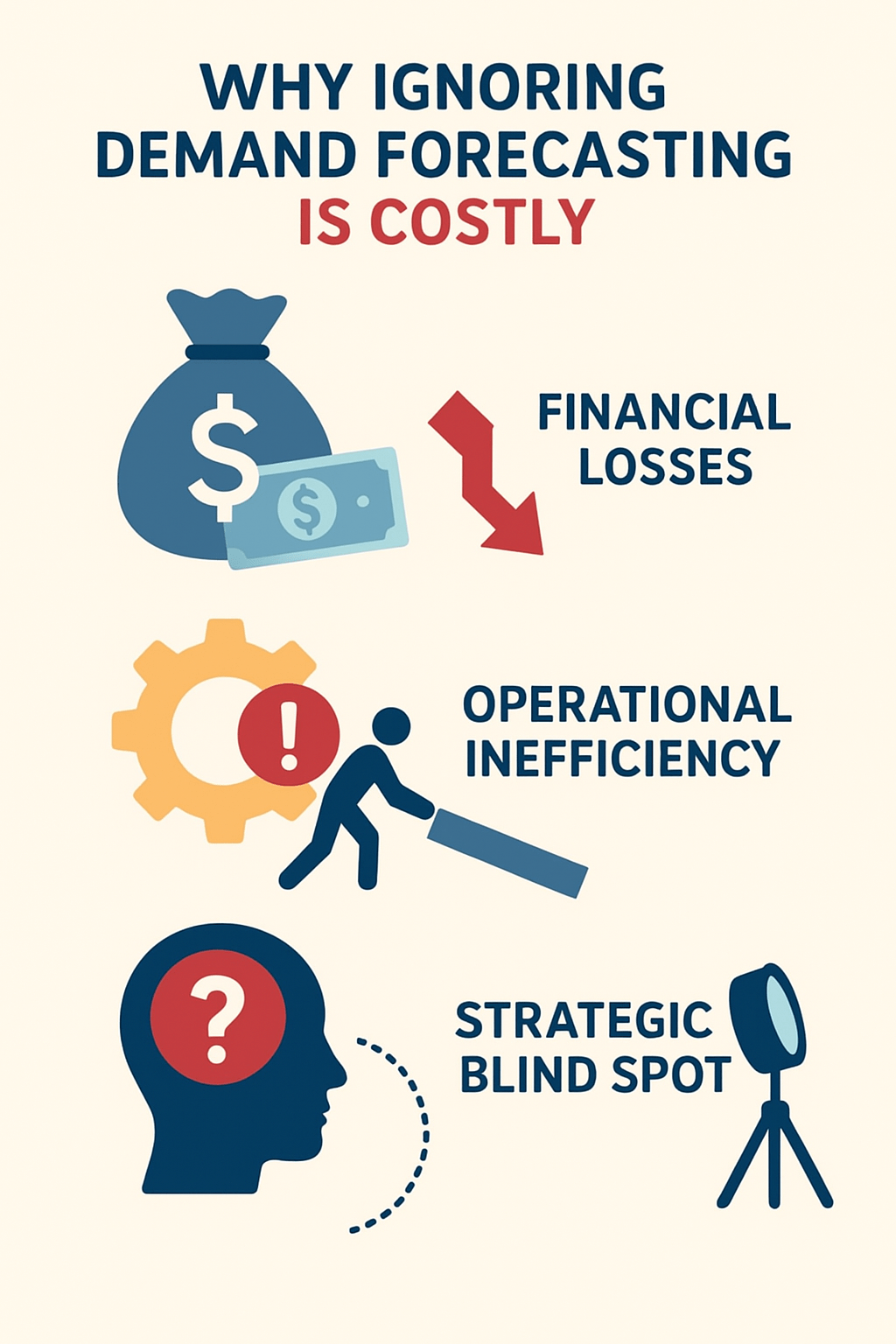What is Demand Forecasting? Types, Methods, and Techniques You Need to Know
Logistics Management
Imagine investing millions in inventory, only to discover that 40% will sit unsold for months. Or picture a sudden surge in demand that leaves your logistics partners scrambling, resulting in delayed shipments and unhappy customers. According to McKinsey & Company, companies that fail to accurately forecast demand can lose up to 10-15% of revenue annually due to stockouts and overstocking. This is the paradox of modern business: the more data we have, the harder it can seem to predict the future.
This is where demand forecasting comes in, a strategic tool that turns uncertainty into actionable insight. But what exactly is demand forecasting, and why is it so critical for businesses today? Let's break it down.
Also Read: https://ilsportal.io/blogs/functions-of-retailing
Why Ignoring Demand Forecasting is Costly
Many businesses, especially in ecommerce and logistics, underestimate the financial and operational risks of poor demand prediction. Here's how:

1. Financial Losses
- Overstocking leads to wasted capital and increased storage costs. For instance, Statista reports that unsold inventory in the retail sector costs $1.75 trillion globally each year.
- Understocking results in missed sales and dissatisfied customers, eroding brand loyalty.
2. Operational Inefficiency
- Without precise forecasts, logistics planning becomes reactive rather than proactive, causing shipment delays and higher freight costs.
- Warehouse and supply chain resources are underutilised or overstretched, reducing operational efficiency.
3. Strategic Blind Spots
- Businesses lack clarity for budgeting, procurement, and marketing campaigns.
- Decision-making becomes guesswork, increasing the likelihood of errors during high-demand periods like BFCM (Black Friday Cyber Monday) or festive seasons.
Bottom line: Ignoring demand forecasting isn't just risky, it's expensive.
Why Businesses Struggle with Demand Forecasting
Demand forecasting challenges arise from multiple factors. Let's categorise them systematically:
1. Data Issues
- Fragmented or outdated sales and logistics data.
- Lack of integration between ecommerce platforms, logistics apps, and inventory systems.
2. Market Volatility
- Changing consumer preferences and seasonal demand spikes.
- Competitor promotions and pricing strategies affect buying behaviour.
3. Operational Constraints
- Inefficient warehouse and fulfilment systems.
- Inability to scale logistics rapidly during peak periods.
4. Technological Gaps
- Absence of predictive analytics tools or AI-backed demand forecasting software.
- Reliance on manual spreadsheets leads to errors and delays.
5. Human Factors
- Over-reliance on intuition rather than data-driven insights.
- Lack of training in modern demand forecasting methods and techniques.
Understanding these root causes is crucial before implementing effective solutions.
What is Demand Forecasting?
Demand forecasting estimates the quantity of a product or service consumers purchase over a specific period. Simply put, it predicts the future so businesses can make informed decisions today.
Objectives of Demand Forecasting:
| Objective | Description | Key Metrics |
|---|---|---|
| Inventory Optimization | Ensure stock levels match expected demand | Stock turnover rate, stockout frequency |
| Financial Planning | Align budgets with expected sales | Revenue projections, cost forecasts |
| Logistics Efficiency | Optimize transportation and warehouse planning | Delivery lead times, fulfillment accuracy |
| Marketing Strategy | Inform campaigns and promotions | Conversion rates, campaign ROI |
| Customer Satisfaction | Reduce missed sales and delays | NPS (Net Promoter Score), order fulfillment rate |
Importance of Demand Forecasting:
- Reduces waste: Minimises excess inventory and storage costs.
- Enhances profitability: Aligns supply with actual sales to maximise revenue.
- Supports scalability: Helps businesses grow without operational bottlenecks.
- Improves logistics efficiency: For ecommerce sellers, apps like Indian Logistics Services Shopify App use demand data to streamline shipments and reduce delivery delays.

Types of Demand Forecasting
Demand forecasting is not one-size-fits-all. Businesses use different types depending on data availability, market dynamics, and operational needs.
| Type | Description | When to Use | Example |
|---|---|---|---|
| Qualitative Forecasting | Based on expert opinions, market surveys, and focus groups | New products or markets with limited historical data | A startup launching a new skincare line in India |
| Quantitative Forecasting | Uses historical data and statistical models | Established products with reliable sales data | Forecasting monthly sales of mobile accessories on Shopify |
| Short-Term Forecasting | Covers days to weeks | Daily operations, inventory management | Planning delivery schedules during festive sales |
| Medium-Term Forecasting | Covers months to a year | Marketing campaigns, procurement planning | Seasonal clothing inventory for Diwali |
| Long-Term Forecasting | Covers 1+ years | Strategic planning, expansion decisions | Long-term capacity planning for warehouses in multiple cities |
| Causal Forecasting | Considers external factors affecting demand | Market-driven demand influenced by price, promotions, economy | Predicting demand for electronics during a price drop by competitors |
| Time Series Forecasting | Analyzes patterns over time | Products with historical sales trends | Using Shopify sales data from previous years to predict holiday season demand |
Methods of Demand Forecasting
Businesses choose different demand forecasting methods based on the data type and forecasting horizon.
1. Moving Average Method
- Smooths out short-term fluctuations by averaging historical sales data.
- Best practice: Use a 3–12 month window for seasonal products.
- Example: Forecasting monthly apparel sales for an online clothing store.
2. Exponential Smoothing
- It gives more weight to recent observations and reacts faster to changes.
- Tools: Excel, R, Python, or Shopify analytics integrations.
- Expected outcome: More responsive forecasts for trending products.
3. Regression Analysis
- Examines the relationship between demand and external variables (price, advertising).
- Example: Predicting the effect of a 10% price reduction on sales.
4. Delphi Method
- Experts provide forecasts iteratively to reach consensus.
- Use case: Launching a new product category without historical data.
5. Econometric Models
- Combines statistical methods and economic theory.
- Example: Forecasting logistics demand based on GDP growth, e-commerce adoption, and urban population density.
6. Machine Learning & AI Models
- Leverages large datasets for predictive accuracy.
- Tools: TensorFlow, Azure ML, Shopify AI integrations.
- Example: Uses AI-driven demand insights to optimise courier selection and reduce delivery delays.
Demand Forecasting Techniques
Modern businesses use a mix of demand forecasting techniques for accuracy.
| Technique | Approach | Example |
|---|---|---|
| Historical Sales Analysis | Uses past sales data to identify trends | Seasonal demand spikes for festive products |
| Market Research & Surveys | Captures consumer intent directly | Conducting surveys before launching a new electronics accessory |
| Judgmental Forecasting | Expert intuition and experience | Experienced store managers estimating holiday inventory |
| Statistical Modeling | Advanced quantitative analysis | Regression, moving averages, and exponential smoothing |
| Collaborative Forecasting | Combines inputs from suppliers, partners, and internal teams | E-commerce brand coordinating with logistics apps like ILS Portal for delivery planning |
| Predictive Analytics | AI-driven predictive modeling | Predicting demand surge for FMCG products during special promotions |
Demand Forecasting in Logistics
Effective demand forecasting in logistics ensures timely fulfilment and cost optimisation. Key applications include:
- Route Optimisation: Align delivery schedules with predicted demand peaks to reduce transit times and fuel costs.
- Inventory Distribution: Balance stock across multiple warehouses based on regional demand forecasts.
- Capacity Planning: Prepare logistics management with infrastructure for high-demand periods without overstaffing or underutilisation.
- Carrier Selection: Use historical and predicted demand data to select reliable courier partners via apps like the Indian Logistics Services Shopify App.
Case Study: A Shopify seller using the ILS Portal forecasted a 25% surge in festive orders. By pre-planning shipments and selecting optimal couriers, they reduced delivery delays by 40% and improved customer satisfaction.
How to Implement Demand Forecasting
Implementing demand forecasting doesn't have to be complicated. Here's a practical framework to make it work for your business:
1. Centralise Your Data
Combine all sales, inventory, and logistics data in one place. Integrating with apps like ILS Portal helps track trends and avoid stock imbalances for Shopify stores.
2. Segment Your Products
Not every product behaves the same. Categorise items by demand, seasonality, or profit margin to apply the right forecasting approach for each.
3. Choose the Right Method
Select forecasting techniques based on your product and data. Use historical data for stable items, AI-driven predictive tools for trending products, and causal models for market-sensitive goods.
4. Collaborate Across Teams
Align sales, marketing, procurement, and logistics teams to ensure everyone works from the same demand insights. Regular check-ins help reduce errors and improve planning.
5. Leverage Predictive Analytics
Modern AI tools analyse large datasets to detect patterns and predict demand spikes. Apps like ILS Portal can suggest optimal inventory and logistics planning for peak periods.
6. Monitor and Adjust
Compare actual sales with forecasts, identify gaps, and refine your models regularly. Continuous monitoring keeps your predictions accurate and relevant.
7. Automate Replenishment
Use forecasting to trigger automatic stock transfers or purchase orders. This reduces stockouts, prevents overstocking, and keeps customers happy.
Following these steps, businesses can reduce costs, optimise inventory, and improve customer satisfaction. Demand forecasting becomes a strategic tool, not just a numbers exercise.
- We don't have enough data for forecasting: Initially, qualitative methods like Delphi or market research should be used.
- Forecasting is too complex and time-consuming: Modern tools like ILS Portal and Shopify AI integrations automate analysis.
- Our market is unpredictable: Scenario planning and AI-driven predictive models handle volatility efficiently.
Also Read: https://ilsportal.io/blogs/shipping-and-logistics
Conclusion
Demand forecasting isn't just a business nicety, it's a strategic necessity. By implementing the right demand forecasting techniques and methods, ecommerce and logistics businesses can reduce costs, optimise inventory, improve customer satisfaction, and boost revenue.
For Shopify sellers, tools like ILS Portal provide actionable demand insights, inventory planning, and optimise logistics workflows, making forecasting a reality rather than a guessing game.
Ready to transform your inventory and logistics strategy? Start leveraging demand forecasting today and turn uncertainty into your competitive advantage.
Frequently Asked Questions
1. What is meant by demand forecasting?
Demand forecasting is the process of predicting the future demand for a product or service using historical data, market trends, and analytics. It helps businesses plan inventory, optimise logistics, and improve profitability.
2. What are the five types of demand forecasting?
The five commonly used types are:
- Qualitative Forecasting: Based on expert opinions and market research.
- Quantitative Forecasting: Uses historical sales data and statistical methods.
- Short-Term Forecasting: Focuses on days to weeks for operational planning.
- Medium-Term Forecasting: Covers months, often used for marketing and procurement.
- Long-Term Forecasting: Spans a year or more for strategic business decisions.
3. Why is demand forecasting important for businesses?
Accurate demand forecasting reduces overstocking and stockouts, improves logistics efficiency, enhances customer satisfaction, and increases profitability.
4. How does demand forecasting help in logistics?
In logistics, demand forecasting helps optimise delivery routes, manage warehouse inventory, plan shipping capacity, and select the best courier partners, reducing delays and operational costs.
5. What are the common methods of demand forecasting?
Common methods include moving averages, exponential smoothing, regression analysis, the Delphi method, and AI-based predictive models. Businesses choose the method based on product type, data availability, and market conditions.

